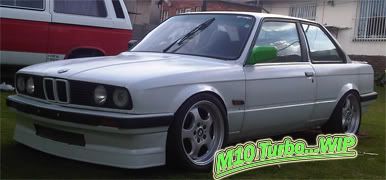the smaller combo wont result in faster piston speeds, you utilise a longer rod length than the 3L so the speeds are reduced at TDC.
Formula for rod ratio is simply rod length / stroke.
As for checking deck heights to match rod/crank/piston sizes, thats easy.
Start with the deck height of the block (206.7mm), this is measured from the crank centerline to the top of the bore. Now take your crank stroke, divide it by half to find the throw. remember, cranks work in both direction, so you use the throw, not the actual stroke length to work out the distance from the crank centerline to the center line of the journal. Next you have the rod length, thats a pretty easy one, then you have the compression height which is the distance from the pin to the crown.
Throw them all together and you can find out dimensions needed to actually fit the components into the engine. Say for example,
84mm stroke of the M52
135mm rods
??? piston compression height to make it work
Compression height = 206.7mm (deck height of the block) - (135mm (rod length) + 42mm (crank throw))
= 29.7mm
Understand how it works? as long as you have 2 figures, you can work out the 3rd easily.
If you want a formula to work out the effective piston speed when it reaches TDC, thats a whole different kettle of fish (but i think you wanted to know the above, with reguards to selecting component sizes).
mmm, compression ratio isnt actually as important as people think, a full point increase in comp ratio results in about a 1.5-2% power gain at most. So, for the purpose of chasing horsepower, you have to weigh up the pro's and con's. In your case, i would probably aim for somewhere around a mid 9:1 ratio (so something like 9.5:1), maybe a little higher to around 10:1 if you get your tuning spot on, but i definately wouldnt go any higher than that (simply because of the fuel octane levels which will reduce the margins of error when tuning and running).
Formula for rod ratio is simply rod length / stroke.
As for checking deck heights to match rod/crank/piston sizes, thats easy.
Start with the deck height of the block (206.7mm), this is measured from the crank centerline to the top of the bore. Now take your crank stroke, divide it by half to find the throw. remember, cranks work in both direction, so you use the throw, not the actual stroke length to work out the distance from the crank centerline to the center line of the journal. Next you have the rod length, thats a pretty easy one, then you have the compression height which is the distance from the pin to the crown.
Throw them all together and you can find out dimensions needed to actually fit the components into the engine. Say for example,
84mm stroke of the M52
135mm rods
??? piston compression height to make it work
Compression height = 206.7mm (deck height of the block) - (135mm (rod length) + 42mm (crank throw))
= 29.7mm
Understand how it works? as long as you have 2 figures, you can work out the 3rd easily.
If you want a formula to work out the effective piston speed when it reaches TDC, thats a whole different kettle of fish (but i think you wanted to know the above, with reguards to selecting component sizes).
mmm, compression ratio isnt actually as important as people think, a full point increase in comp ratio results in about a 1.5-2% power gain at most. So, for the purpose of chasing horsepower, you have to weigh up the pro's and con's. In your case, i would probably aim for somewhere around a mid 9:1 ratio (so something like 9.5:1), maybe a little higher to around 10:1 if you get your tuning spot on, but i definately wouldnt go any higher than that (simply because of the fuel octane levels which will reduce the margins of error when tuning and running).



Comment